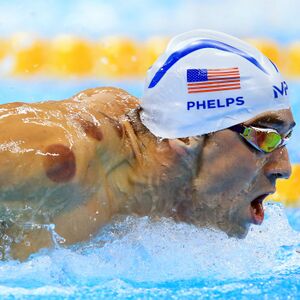Modern Cupping from Clinical Approach
This article is currently under review and may not be up to date. Please come back soon to see the finished work! (29/04/2023)
Top Contributors - {{Special:Contributors/Template:Modern Cupping Therapy from Clinical Approach}}
Introduction[edit | edit source]
Cupping Therapy is a universal practice in the east and west, where it's popularity has been spanned in the modern communities when Michael Phelps-Olympic gold medal winner, was seen with cupping marks in Rio de Janeiro in Brazil 2016[1]. Cupping Therapy is an alternative medicine that sometimes referred to suction therapy based on it's mechanism of action or Myo-fascial Decompression Therapy[2]. Different types of cupping therapy have been used to treat many diseases with different conditions that included improvement of sports performance[1].
Updated classification of cupping therapy is developed and more types of cupping therapy are categorised, this 6 criteria classification includes [3][4]: Area treated category, material inside the cups and sixth category is other cupping types for example: sports, cosmetic, and aquatic cupping[4].
Evidence to date:[edit | edit source]
An overview of systematic reviews assessed the safety and effectiveness of cupping therapy for 11 disease through an evidence based approach[5]. Results of multiple systematic reviews showed that cupping therapy (alone or combined with other interventions) was better than medications (or other interventions alone) for different diseases included cervical spondylosis and low back pain, although one review reported adverse effects like increase in pain and tingling after cupping treatment[5]Overall, Cupping may be beneficial for pain relief[5][6], On the other note, the insufficient number of reviews and the poor qualities of the original studies couldn't firm the conclusive results[5][7].
The mechanism of action of cupping therapy was not clear until now [6].
Benefits on MSK problems[edit | edit source]
Cupping may be an effective tool with low risk in treating nonspecific, musculoskeletal pain like back, neck and shoulders[6]. Different types of cupping therapy were used in studies (wet cupping, dry, moving,etc.
Pain:(neck, heal, backpain).
Cupping therapy has therapeutic effects in treatment of Carpal Tunnel Syndrome.[8]
Trigger point:
Post partum:
Peripheral nerve entrapments:
Benefits on Respiratory system[edit | edit source]
cough reflex,
Benefits on Lymphatic system[edit | edit source]
Proposed mechanisms of actions have suggested effects of sub-atmospheric pressure suction, promoting peripheral blood circulation, and improving immunity[9]
swelling, CRC cancer.
Benefits on sports performance[edit | edit source]
When reporting on the use of cupping among elite athletes, the National Broadcasting Company stated that cupping is a “therapy technique that athletes use to help their muscles recover and perform at their best[10].
ITB , Planter fascia-ties, hamstrings, shin splint.
Case Scenario[edit | edit source]
Conclusion[edit | edit source]
Resources[edit | edit source]
- bulleted list
- x
or
- numbered list
- x
References[edit | edit source]
- ↑ 1.0 1.1 Musumeci G. Could cupping therapy be used to improve sports performance?. Journal of Functional Morphology and Kinesiology. 2016 Oct 27;1(4):373-7.
- ↑ References 1.Warren AJ, LaCross Z, Volberding JL, O’Brien MS. Acute outcomes of myofascial decompression (cupping therapy) compared to self-myofascial release on hamstring pathology after a single treatment. Int J Sports Phys Ther [Internet]. 2020;15(4):579–92. Available from: http://dx.doi.org/10.26603/ijspt20200579
- ↑ Aboushanab TS, AlSanad S. Cupping therapy: an overview from a modern medicine perspective. Journal of acupuncture and meridian studies. 2018 Jun 1;11(3):83-7.
- ↑ 4.0 4.1 Al-Bedah AM, Aboushanab TS, Alqaed MS, Qureshi NA, Suhaibani I, Ibrahim G, Khalil M. Classification of cupping therapy: a tool for modernization and standardization. Journal of Complementary and Alternative Medical Research. 2016 Jun;1(1):1-0.
- ↑ 5.0 5.1 5.2 5.3 Cao H, Han M, Zhu X, Liu J. An overview of systematic reviews of clinical evidence for cupping therapy. Journal of Traditional Chinese Medical Sciences. 2015 Jan 1;2(1):3-10.
- ↑ 6.0 6.1 6.2 Cao H, Li X, Liu J. An updated review of the efficacy of cupping therapy. PloS one. 2012 Feb 28;7(2):e31793.
- ↑ Cao H, Li X, Yan X, Wang NS, Bensoussan A, Liu J. Cupping therapy for acute and chronic pain management: a systematic review of randomized clinical trials. Journal of Traditional Chinese Medical Sciences. 2014 Jul 1;1(1):49-61.
- ↑ Michalsen A, Bock S, Lüdtke R, Rampp T, Baecker M, Bachmann J, Langhorst J, Musial F, Dobos GJ. Effects of traditional cupping therapy in patients with carpal tunnel syndrome: a randomized controlled trial. The journal of pain. 2009 Jun 1;10(6):601-8.
- ↑ Zeng K, Wang JW. Clinical application and research progress of cupping therapy. Journal of Acupuncture and Tuina Science. 2016;4(14):300-4.
- ↑ Olympics NB. Why does Michael Phelps have purple spots on his back.







